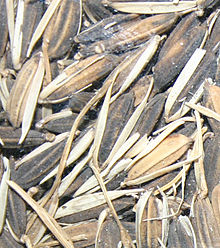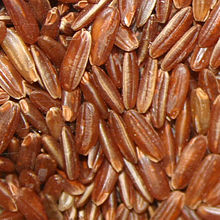Oryza glaberrima: Difference between revisions
extensive rewrite Tag: nowiki added |
|||
| Line 90: | Line 90: | ||
===American cultivars=== |
===American cultivars=== |
||
''See also [[Rice production in the United States]].'' |
|||
Carolina Gold is an heirloom cultivar grown in the early United States, sometimes known as golden-seed rice for the colour of its grains. |
Carolina Gold is an heirloom cultivar grown in the early United States, sometimes known as golden-seed rice for the colour of its grains. |
||
Revision as of 23:01, 9 August 2016
| Oryza glaberrima | |
|---|---|

| |
| Seeds of Oryza glaberrima | |
| Scientific classification | |
| Kingdom: | |
| Division: | |
| Class: | |
| Subclass: | |
| Order: | |
| Family: | |
| Subfamily: | |
| Tribe: | |
| Genus: | |
| Species: | O. glaberrima
|
| Binomial name | |
| Oryza glaberrima | |
Oryza glaberrima, commonly known as African rice, is one of the two domesticated rice species.[1] It was once grown widely in Africa, and was brought to the Americas by African slaves.
When it was once almost entirely replaced by higher-yielding Asian rice,[2] it persisted for cultural reasons; for instance, it is sacred to awasena followers among the Jola people,[3] and is a heritage variety in the United States.
Since African rice is much hardier than Asian rice, crossbreeding produced the nerica cultivars (new rice for Africa), hardy and high-yielding, whose use is now expanding across Africa. A similar cross-bred variety was introduced in the United States in 2011.
History

Humans have independently domesticated two different rice species. African rice was domesticated from wild African rice, Oryza barthii, while Asian rice (Oryza sativa), was domesticated from wild Asian rice, Oryza rufipogon.
Oryza barthii still grows wild in Africa, in a wide variety of open habitats. It is believed to have been domesticated 2000–3000 years ago in the inland delta of the Upper Niger River, in what is now Mali.[2][1]. It then spread through West Africa.
Wild rice seedheads shatter, scattering the rice grains to seed the next generation. Domestic rice does not shatter, making the grains easy for humans to gather. A mutation that caused rice not to shatter would have been the beginning of domestication.
Ibn Baṭṭūṭa recorded rice couscous in the area of present-day Mali in 1350.[citation needed]
In the late fifteenth and sixteenth centuries, Portuguese ships sailed to the Southern Rivers area in West Africa and wrote that the land was rich in rice. [T]“hey said they found the country covered by vast crops, with many cotton trees and large fields planted in rice … the country looked to them as having the aspect of a pond (i.e., a marais)”. The Portugese accounts speak of the Falupo Jola, Landuma, Biafada, and Bainik growing rice. André Álvares de Almada wrote about the dike systems used for rice cultivation.[1]
African rice was brought to the Americas with the transatlantic slave trade, arriving in BRazil probably by the 1550s[4] and in the U.S. 1784.[5] The seed was carried as provisions on slave ships[4], and the technology and skills needed to grow it were brought by slaves. Newly-imported African slaves were marketed for their rice-growing skills, as the high price of rice made it a major cash crop. The tolerance of African rice for brackish water meant it could be grown on coastal deltas[6][7]
There are numerous stories about how the rice came to North America[8], including a slave hiding grains in her hair[4] and a ship driven in to trade by a storm.[9]
Asian rice came to West Africa in the 1890s, and by the late twentieth century had largely supplanted native African rice in all but marginal areas.[10]
The 2007 food price shocks drove efforts to raise rice production. Rice-going regions of Africa are generally net rice importers, so price increases hurt. Among the efforts to increase yield were the nerica cultivars, crossbred to specifications from local farmers using African rice varieties provided by local farmers.[1]
Cooking
 |
 |
 |
African rice is freshly harvested, puffed in fire, and eaten. Fried rice have browny color when fried this is because of the husk that is green in color when heated turns brown [clarification needed].
African rice can be directly substituted into most Asian rice recipes, although it has a distinct flavour.[1]
Traits
Appearance
Generally, African rice has small, pear-shaped grain, reddish bran and green to black hulls, straight, simply-branched panicles, and short, rounded ligules. There are, however, exceptions, and it can be hard to distinguish from Asian rice.[1] For complete certainty, a genetic test can be used.
Hardiness
African rice is well adapted to the African environment. It is drought- and deep-water-resistant, and tolerates fluctuations in water depth, iron toxicity, infertile soils, severe climatic conditions, and human neglect better than Asian rice. [11][1] Some varieties also mature more quickly, and may be sown directly on higher ground, eliminating the need to transplant seedlings.[1]
African rice has profuse vegetative growth, which smothers weeds. It exhibits better resistance to various rice pests and diseases, such as blast disease, African rice gall midge (Orseolia oryzivora), parasitic nematodes (Heterodera sacchari and Meloidogyne spp.), rice stripe necrosis virus, rice yellow mottle virus, and the parasitic plant Striga. [11]
Yield and processing
Most African rices shatter more than Asian rices, possibly because they haven't been domesticated for as long. A few varieties of African rice are as resistant to shattering as shatter-resistant Asian varieties, but most are not; on average, about half of the grains are scattered and lost. This is why yield is lower; when the heads of African rice are bagged before they become ripe, so that the shattered grains are caught in paper bags, the yield of African rice is the same as the yield of Asian rice.[12]
Like other grains, rice may lodge, or fall over, when grain heads are full. African rice's greater height makes it more likely to lodge, although it also lets it survive in deep water, and makes it easier to harvest. African rice tend to elongate rapidly if completely submerged, which is not advantageous in regions prone to short floods, as it weakens the plant.
The grains of African rice are more brittle than those of Asian rice. The grains are more likely to break during industrial polishing.[13] Broken rice is widely used in West Africa, and some cookbooks from the region will suggest manually breaking the grains for certain recipes[14], but most broken rice eaten is from Asian rice, about 16% of which is broken in processing.
The genome of O. glaberrima has been sequenced, and was published in 2014,[15] and it has been studied in the context of the genetic diversity of the genus.[16]
Cultivars
African cultivars
There are a great many varieties of African rice. In the 1960s older women in Jipalom could name more than ten varieties of African rice that were no longer planted, besides the half-dozen that were then still being planted. Each woman would plant multiple different varieties, to suite varying microhabitats and to stagger the harvest[1]
Varieties, each with subtypes, include:[1]
- Variety rustica
- Variety rigida
- Variety evoluta
- Variety aspera
- Variety ebenicolorata
The cultivars the Africa Rice Center calls TOG 12303 and TOG 9300 have low shattering, and thus yields comparable with low-shattering Asian rice varieties.[11]
Scientists from the Africa Rice Center managed to cross-breed African rice with Asian rice varieties to produce a group of interspecific cultivars called New Rice for Africa (NERICA).[17]
American cultivars
See also Rice production in the United States.
Carolina Gold is an heirloom cultivar grown in the early United States, sometimes known as golden-seed rice for the colour of its grains.
Long-grain gold-seed rice boasted grains 5/12ths of an inch long (up from 3/8ths of an inch), and was brought to market by planter Joshua John Ward in the 1840's. Despite its popularity, the variety was lost in the American Civil War.[5]
Charleston Gold was released in 2011 and is a crossbreed of Carolina Gold and two Oryza sativa breeding lines called IR64 (Indica[18]) and IR65610-24-3-6-3-2-3, which raised the yield, shortened the stem, and added an aromatic quality to the rice.[5]
References
- ^ a b c d e f g h i j Linares, Olga F. (2002-12-10). "African rice (Oryza glaberrima): History and future potential". Proceedings of the National Academy of Sciences. 99 (25): 16360–16365. doi:10.1073/pnas.252604599. ISSN 1091-6490 0027-8424, 1091-6490. PMID 12461173. Retrieved 2016-08-09.
{{cite journal}}: Check|issn=value (help) - ^ a b Wang, Muhua; Yu, Yeisoo; Haberer, Georg; Marri, Pradeep Reddy; Fan, Chuanzhu; Goicoechea, Jose Luis; Zuccolo, Andrea; Song, Xiang; Kudrna, Dave; Ammiraju, Jetty S. S.; Cossu, Rosa Maria; Maldonado, Carlos; Chen, Jinfeng; Lee, Seunghee; Sisneros, Nick; de Baynast, Kristi; Golser, Wolfgang; Wissotski, Marina; Kim, Woojin; Sanchez, Paul; Ndjiondjop, Marie-Noelle; Sanni, Kayode; Long, Manyuan; Carney, Judith; Panaud, Olivier; Wicker, Thomas; Machado, Carlos A.; Chen, Mingsheng; Mayer, Klaus F. X.; Rounsley, Steve; Wing, Rod A. (2014-09). "The genome sequence of African rice (Oryza glaberrima) and evidence for independent domestication". Nature Genetics. 46 (9): 982–988. doi:10.1038/ng.3044. ISSN 1061-4036. Retrieved 2016-08-09.
{{cite journal}}: Check date values in:|date=(help) - ^ Senegal: Modern Senegalese Recipes from the Source to the Bowl by Pierre Thiam and Jennifer Sit (Lake Isle Press, 2015). Online extract about African rice
- ^ a b c ‘With Grains in Her Hair’: Rice in Colonial Brazil, Judith A. Carney. http://www.sscnet.ucla.edu/geog/downloads/594/33.pdf
- ^ a b c Charleston Gold: A Direct Descendant of Carolina Gold, by David S. Shields. Rice Paper, Vol. 5 No. 1
- ^ http://ldhi.library.cofc.edu/exhibits/show/forgotten_fields/decline_in_inland_rice
- ^ https://ricediversity.org/outreach/educatorscorner/documents/Carolina-Gold-Student-handout.pdf
- ^ The Golden Seed, by David S. Shields. Rice Paper, Vol. 5 No. 1
- ^ http://www.carolinaplantationrice.com/history/
- ^ [1]
- ^ a b c Montcho, D.; Futakuchi, K.; Agbangla, C.; Fofana, M.; Dieng, I. (2013-01-01). "Yield loss of Oryza glaberrima caused by grain shattering under rainfed upland conditions". International Journal of Biological and Chemical Sciences. 7 (2): 535–543. doi:10.4314/ijbcs.v7i2.10. ISSN 1997-342X. Retrieved 2016-08-09.
- ^ Montcho, D.; Futakuchi, K.; Agbangla, C.; Fofana, M.; Dieng, I. (2013-01-01). "Yield loss of Oryza glaberrima caused by grain shattering under rainfed upland conditions". International Journal of Biological and Chemical Sciences. 7 (2): 535–543. doi:10.4314/ijbcs.v7i2.10. ISSN 1997-342X.
- ^ Carney 2009
- ^ http://congocookbook.com/rice_recipes/index.html
- ^ Zhang, QJ.; Zhu, T.; Xia, EH.; Shi, C.; Liu, YL.; Zhang, Y.; Liu, Y.; Jiang, WK.; et al. (Nov 2014). "Rapid diversification of five Oryza AA genomes associated with rice adaptation". Proc Natl Acad Sci U S A. 111 (46): E4954–E4962. doi:10.1073/pnas.1418307111. PMID 25368197.
- ^ http://www.pnas.org/content/111/46/E4954
- ^ Jones, Monty P.; Dingkuhn, Michael; Aluko/snm>, Gabriel K.; Semon, Mandé (1997-03-01). "Interspecific Oryza Sativa L. X O. Glaberrima Steud. progenies in upland rice improvement". Euphytica. 94 (2): 237–246. doi:10.1023/A:1002969932224. ISSN 0014-2336.
- ^ http://www.ncbi.nlm.nih.gov/pubmed/16988345
Further reading
- Oryza glaberrima: A source for the improvement of Oryza sativa
- Carolina Gold
- Shields, David S; Carolina Gold Rice Foundation (2010). The golden seed: writings on the history and culture of Carolina gold rice. United States: Douglas W. Bostick for the Carolina Gold Rice Foundation. ISBN 978-0-9829792-1-1.
- "Black Rice — Judith A. Carney". 2002. ISBN 9780674008342. Retrieved 2016-08-09.
{{cite web}}: Text "Harvard University Press" ignored (help) - Identification of a rice stripe necrosis virus resistance locus and yield component QTLs using Oryza sativa × O. glaberrima introgression lines
